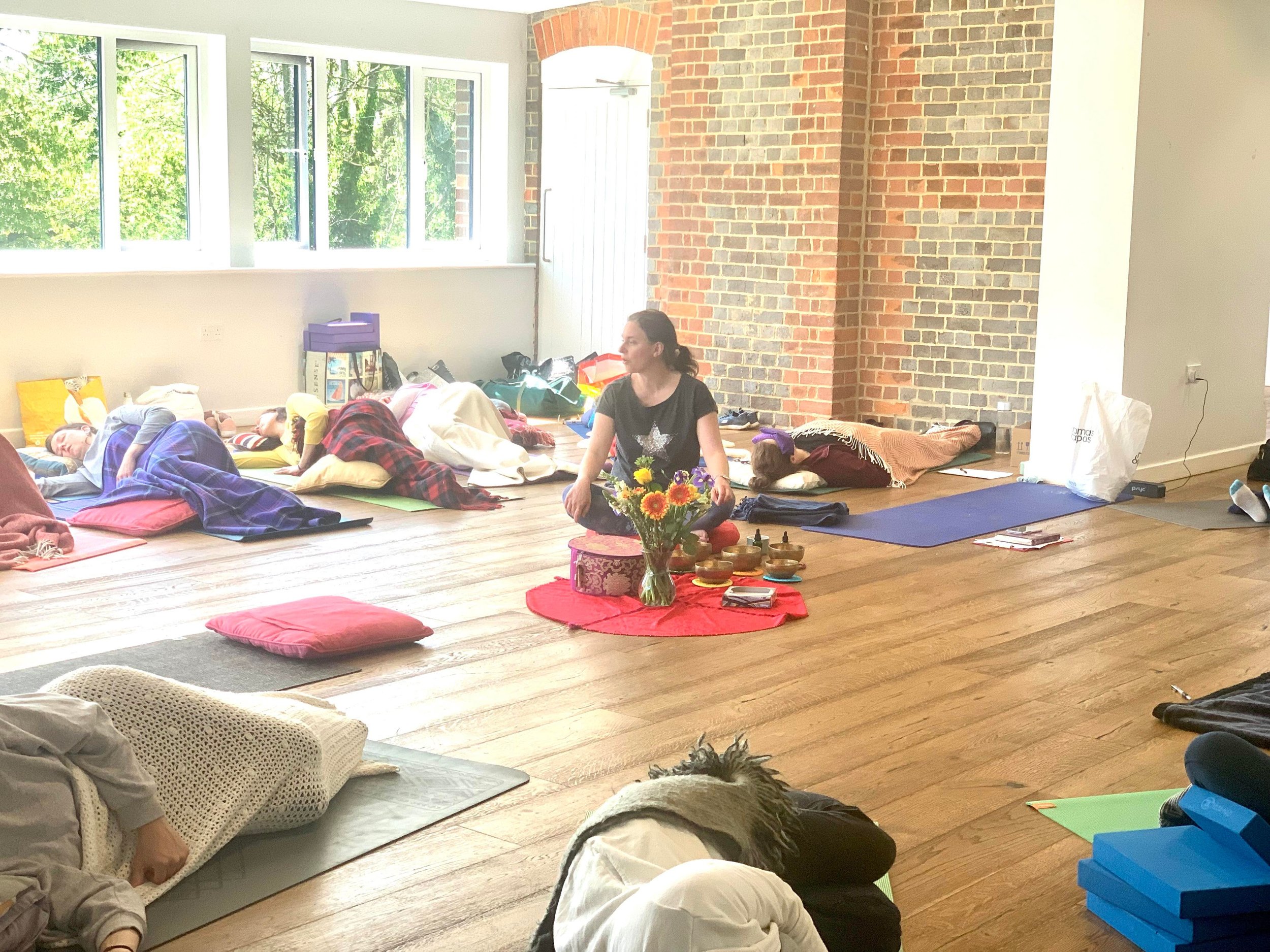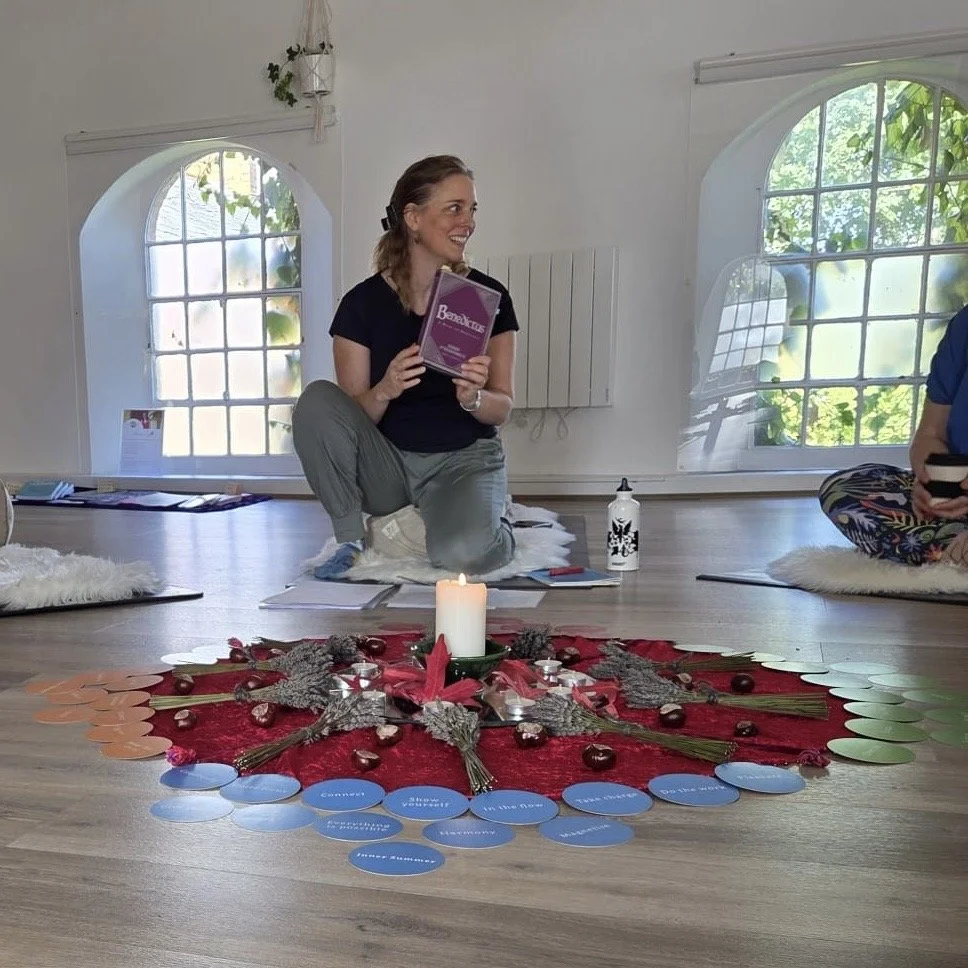
How and why Yoga Nidra works - The Science
If you’ve experienced a Yoga Nidra relaxation, I hope you’ve emerged at the end feeling rested and transformed in some way.
Maybe you’ve experienced different types of Yoga Nidra and felt some have been more restful than others. Why is that? Why are there specific components like intention-setting, body rotation (or body mapping), opposites and so on? Is there any research behind it?
Tessa Venuti Sanderson has been teaching Yoga Nidra for 15 years. She is a former academic researcher and dived into the studies to see what science can tell us about this technique…
When I run trainings for people to learn how to teach Yoga Nidra, a common question is, “I know I feel good afterwards, but how does it work?” This article is an overview of the specific parts of the technique and what their function is, and why this makes Yoga Nidra different from general relaxation.
Yoga Nidra has evolved through different lineages and when you listen to tracks you might find that there are variations in how it’s delivered. However, most have these sections: settling, an intention/ sankalpa, body mapping, opposites, a bonus section (including imagery, visualisations or hypnotic deepners) and coming out. We’ll look at these in turn.
Settling for the practice
All relaxations that I have listened to talk through how to settle the body, mind and breath. Sometimes, this constitutes the whole practice for a short, general relaxation. For a Yoga Nidra, it is just the beginning and supports the listener to be physically comfortable, to start to settle the nervous system and prepare to receive the deeper practice.
Try one of my Yoga Nidra’s now - this one helps you fall asleep and leaves you asleep so be sure to put on an alarm if you need to be somewhere on time!
Intention / sankalpa in Yoga Nidra
In some traditions, this is a crucial part of the practice and a lifelong intention may be chosen to repeat each time Yoga Nidra is undertaken. Taking a moment to choose an intention can help set the tone for the practice and orientate the participant towards a positive mindset.
Using a Neurolinguistic Programming approach, it is important that the intention is phrased in the present tense and avoiding double negatives, such as “I am not stressed” as the brain will focus on the “stressed” and a better alternative could be “I am calm”.
I prefer to have people think about their intention before they lie down to practice within a class or workshop situation as it is a cognitive activity and once we start the Yoga Nidra practice, we want them to move away from the frontal cortex as we will see later.
Journaling and preparing a meaningful intention is one way of approaching this. If it is for a recording, where you don’t have the opportunity to prepare before, an option could be to offer a couple of simple intentions that they could adopt or suggest that they choose a simple one of their own wording.
If you are instructing them to invite a certain quality like wellbeing or happiness, this can have the effect of switching on the speech and language centres of the brain. This is effective with children. You could ask, “What would you like to feel at the end of this? Feeling happy? Feeling snuggly? Or something else?”
It is also important to allow the possibility for not coming up with one as we don’t want people to worry about getting the words or feeling correct rather than moving into the practice.
Body mapping / body rotation
I admit it! This is my favourite part and the bit that always sends me into a state of deep rest. Why? There are different body maps that a practitioner can talk through during the Yoga Nidra and they can be shorter or longer.
The longer ones tend to spend a lot of time around the hands, feet and face. The reason for this is that we have a lot of nerve endings in these places and as the parts (e.g. thumb, index finger, middle finger, ring finger, little finger) are talked through, this lights up the corresponding parts of the brain. Sometimes you will see people wriggling their fingers and toes as those parts are mentioned.
The skill of the body rotation is to have consistency as you move around the body so that the person can follow along. By bringing awareness to the different body parts, attention is shifted from the frontal cortex (the justifying, rationalising part of the brain where we spend most of our time) into the visual and tactile centres of the brain. You can see this in brain scans here: https://www.yogameditation.com/reading-room/pictures-of-the-brains-activity-during-yoga-nidra/
What can happen is that the brain follows along for a while and then moves into deeper brain waves (from Beta (alert state) to Alpha (relaxed state) to Theta and possibly Delta e.g. in this electrophysiology study) because of the repetition such as big toe, second toe, third toe, fourth toe, little toe. Another technique that can help this is moving from left to right, for example, left hip, right hip, left knee, right knee, left ankle, right ankle etc. Even reading it, you can see how it has a hypnotic and soporific (sleep-inducing) effect.
Yoga Nidra is an adaptogenic technique: that is, it gives you what you need. You may fall asleep if you are very tired and this is no bad thing. In fact, there are many tracks specifically to help people get to sleep such as this one as the one further up this page. However, if you are doing this as a spiritual practice, you may prefer to stay awake by practicing Yoga Nidra in the morning when you are fresh, by sitting and/or by not being overly warm.
Care needs to be taken in which parts of the body to name. Where there has been trauma, there might be parts of the body that feel unsafe and lead people to disassociate or have some other reaction. To work in a trauma-informed way, it is important to give different options for how to engage with the body mapping. For example, you may establish a neutral or safe space within a person’s body that can come back to at any time they feel triggered and give lots of permission around opening their eyes, moving position etc.
Opposites section in Yoga Nidra
This is another important component of the technique for lighting up other parts of the brain. In this image, you can see how talking about different degrees of cold or heat moved the activity of the brain to different centres (Thalamic and Cortison Activtations study).
Common opposites used in Yoga Nidra can be warm/cold, heavy/light, light/shade, left/right. By invoking these opposites one after the other, you repeatedly are moving where activity in the brain is happening. After a while this can cause the conscious brain to switch off and either fall asleep or move into those deeper brain waves associated with rest.
The visual and somatosensory centres can be activated in this way. For example, visualising an acorn and then a magnificent oak tree would activate the visual centre. Inviting someone to experience their body as heavy and then as light would activate the somatosensory centre.
It is important to give consideration to the types of states being invoked. You may have listened to yoga nidras where they invite you to connect with anger then joy, but I would advise against using extremes as this may trigger unwanted memories or reactions. A trauma-informed approach is to offer something milder, particularly in a group situation or with a new client, and also offer the possibility of choosing something else. One person’s joyous ride in a hot air balloon could be another person’s worst nightmare!
The Use of Visualisation and Journeys in Yoga Nidra
Something that people often enjoy is to be taken on a journey of some kind. This can be a way of preventing people falling asleep because they’re following along. Examples are to take your listeners into a secret garden where they feel safe and relaxed, to go on a walk and discover a little house that is as if designed just for them where they can go to rest.
From a trauma-informed perspective, giving choice is helpful, such as you look around you and see all sorts of plants and flowers, instead of you see buddleia, weeping willows and dahlias. First, people may not be familiar with the specific plants you’ve chosen, but second, they might have specific memories or associations with those. If you leave it open, they can fill in the gaps with the specifics of things that are comfortable for them.
Invoking the senses is the most effective way of activating a range of brain centres, so wherever you take someone in their imagination or memory, ask them for the things they can see, feel, hear, smell and taste. Invoking a landscape seems to be a concrete task that activates the visual and tactile centres of the brain.
Affirmations
Bringing in affirmations at this point of the Yoga Nidra can be very powerful because the listener will be in a relaxed and more suggestive state. This is why we need to approach the practice with a code of ethics.
By invoking feelings such as happiness, of being centred or grounded, the speech and language centres in the brain can be activated. These are more abstract tasks compared to the concrete tasks of following the body mapping or experiencing the description of a detailed landscape.
As with the intention/ sankalpa above, it’s important to phrase the affirmations in the present tense and with no double negatives. I like to use the concept of a spectrum of feeling, such as “I am moving towards deep relaxation”. This means that if someone isn’t currently experiencing deep relaxation, their brain won’t react negatively to the statement. It also allows for a variety of states in a group class.
If you’ve come across other techniques in this bonus section, let me know and I’ll add them in with a commentary! Email Tessa.
The ‘Bonus section’ in Yoga Nidra
A Yoga Nidra could be very effective without this section, but there are techniques you can use that add another opportunity of moving people into those deeper brain waves. It’s also potentially a very creative section where you go to town on a theme.
The use of imagery in Yoga Nidra
A common technique here is the use of imagery. Some traditions use a long list of strong images to help activate different parts of the brain.
From a trauma-informed approach, I feel that the more images you include, the more possibility of using a triggering image. My preference is for choosing one image that you can be creative with. For example, inviting people to consider an oak tree gives the possibility of talking about the trunk, the branches, leaves, the roots, the birds and animals that live there. You can easily check in with everyone if they are ok with an oak tree before starting the practice.
The use of imagery particularly can activate the visual centre of the brain, but also the somatosensory part if you include senses. E.g. the rough bark on the trunk and the lightness of the leaves.
If you’d like to learn how to teach in this way and create your own scripts, take a read…
Hypnotic deepners
An effective technique is to use counting downwards to support the brain to switch into a liminal state, that is, a daydreamy feeling where the brain waves are slowing down. Inviting someone to count down from 100 can have this effect, but it’s important to reassure them at the beginning that it’s absolutely ok if they loose track. They do not need to count all the way to 0! At a certain point, you can invite them to let go of the counting, wherever they got to.
What works really well is to combine the counting with imagery to switch on more brain centres. For example, going for a walk and see a set of steps in front of you and counting each one as you go down. You can also use this for coming out of the practice at the end, but instead counting upwards.
One word of caution about counting down from a smaller number is that sometimes people will associate this with surgery and having a general anaesthetic. This is generally not a good memory and not one they want to visit.
Coming out of Yoga Nidra practice
An equally important part of Yoga Nidra is how someone is brought out of the practice. Supporting people to become aware of the environment around them can be one way of doing this, for example, “Become aware of the sound of your breath, making a sigh or a yawn now so you can hear your breath. Become aware of other sounds in the room. What is the furthest away sound you can hear outside?”
Bringing their attention to the environment around, will support them to transition gently and be ready to sit up, perhaps share their experience (see why I teach Circle Facilitation as part of Yoga Nidra) and go out into the world in a state of alert relaxation.
Once people are sitting up after the practice, it is a good idea to ask them to share a couple of words about how they feel or one thing they remember about the relaxation. This is a good way of helping to switch on the frontal cortex again ready to find their way home. I did hear of one teacher’s student who went the wrong way on the underground train after a particularly deep relaxation!
The use of Bilateral Stimulation (BLS) in Yoga Nidra
I want to mention this technique because it can be incredibly effective for activating the parasympathetic nervous system and counteracting the fight or flight response. It creates a neurological experience that calms the nervous system and regulates emotional responses.
You can listen to my track using this here: (Headphones recommended)
It’s an advanced technique and you may have heard of it in connection with treatment for trauma. It mimics the Rapid Eye Movement (REM) sleep phases and is crucial for emotional processing where trauma has occurred.
The theory is that the left to right, back and forth patterns bridge the gap between rational though and emotional distress. BSL can create a cognitive detour where other routes are normally blocked by traumatic ‘highways’. That is, because of trauma, the brain habitually reacts in certain ways that might be maladaptive. The amygdala in the brain can become hypersensitive or overreactive to stimuli it perceived as threatening and a person can feel stuck.
The BSL begins to recognise a traumatic memory as a past event, rather than an immediate threat that keeps replaying. This means the brain has an opportunity to re-evaluate traumatic experiences. If someone has experienced trauma, it is important that they seek support from a qualified professional to treat the impact. I have included this information to show how powerful these techniques can be and how Yoga Nidra can be a supportive modality to treatment.
Yoga Nidra in Research
Below are some studies that have researched the effectiveness of yoga nidra, in case you would like some specific examples. They tend to be small in size, but well conducted.
Students show increase in wellbeing after 3 weeks of yoga nidra
Even 11 mins of yoga nidra a day for 30 days is beneficial
Benefits of yoga nidra persist through the day
Self-esteem improves and life stress decreases after 8 weeks of yoga nidra
8 weeks of iRest Yoga Nidra for PTSD vetrans show benefit
I listen to Yoga Nidra nearly every day because it is an effective way of resting deeply and quickly. I also find that it creates space for my creativity to come through and has played a major role in me writing eight books! Hopefully now you have an appreciation of the technicality as well as the art of delivering an effective Yoga Nidra practice.
If you think a friend or colleague would benefit from this page, please share the URL. Thanks!










